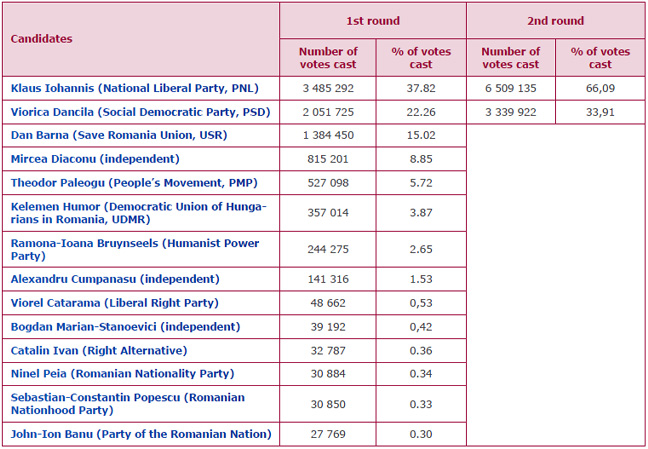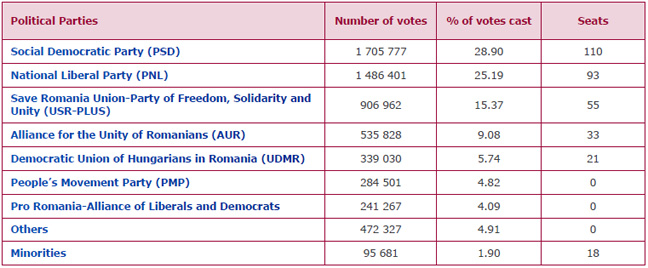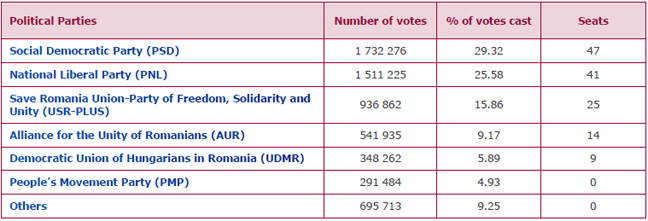Analysis
Elections in Europe
Corinne Deloy
-

Available versions :
EN

Corinne Deloy
Six months after voting in the European and local elections on 9 June, Romanians are being called to the polls to renew their President of the Republic on 24 November (and on 8 December in the event of a 2nd round) and all the members of Parliament (MPs and senators) on 1 December (Romanian National Day).
31 political parties are in the running for the parliamentary elections and 14 for the presidential election.
For the first time since 2004, the 2 elections will be held in the same year. The outgoing government, a ‘grand coalition’ comprising the National Liberal Party (PNL) of Nicolae Ciuca, former Prime Minister (2021-2023), and the Social Democratic Party (PSD) of outgoing Prime Minister Ion-Marcel Ciolacu, did not want the two elections to be held on the same day.
The PSD won the local elections on 9 June. On the same day, the PSD-PNL alliance won the European elections with 48.55% of the vote (i.e. 19 of the 33 elected to the Strasbourg parliament, 11 for the PSD and 8 for the PNL) ahead of the right-wing populist party, Alliance for the Unity of Romanians (AUR), which won 14.93% of the vote and 6 seats.
The Presidential Campaign
14 people are in the running to replace Klaus Iohannis, who has been President of the Republic since 2014. The outgoing head of State, who is completing his 2nd term in office, is not eligible for re-election. 10 candidates are being put forward by political parties and 4 are running as independents.
The 14 candidates are:
- Ion-Marcel Ciolacu (Social Democratic Party, PSD), the outgoing Prime minister, was nominated as a candidate on 24 August. He has indicated that, in the event of victory, he would like to see the appointment of a prime minister from a party other than his own because, he stressed, ‘power must be shared’;
- Nicolae-Ionel Ciuca (National Liberal Party, PNL), former Prime minister (2021-2023), military officer and former defence minister (2019-2021). He wants to place military values such as ‘honesty, trust, keeping one's word and love of country’ at the heart of the political sphere;
- George-Nicolae Simion, (Alliance for the Unity of Romanians, AUR);
- Elena-Valeria Lasconi (Save Romania Union, USR), who succeeded Catalin Drula at the head of the liberal party after the latter resigned following the party's disappointing results in the Last Juen local elections;
- Mircea-Dan Geoana (independent), former deputy secretary general of NATO, a post he left to run in the presidential election. He says he ‘wants to put Romania above parties and Romanians above politics’ and has made education and health his priorities. This former member of the PSD has succeeded in attracting members of the middle class who are closer to right-wing parties and young people who are unfamiliar with his past;
- Hunor Kelemen (Democratic Alliance of Hungarians in Romania, UDMR);
- Cristian Diaconescu (People’s Movement Party, PMP);
- Cristian-Vasile Terhes (National Conservative Party, PNCR);
Ludovic Orban, leader of Force of the Right (FD), former Prime minister (2019-2020) which he founded in 2021 after leaving the PNL. Orban claims to be the only man capable of defeating the PSD, and that liberal voters have been betrayed by the PNL, which governs with and is dominated by the PSD. ‘I have a message for the liberals Klaus Iohannis and Nicolae-Ionel Ciuca who are hostages of the PSD which wants to keep you in this state of servitude for another 4 years.The PNL leaders have forgotten liberalism (...) It's time to act. Leave Klaus Iohannis and Nicolae-Ionel Ciuca to lick the PSD's boots and join me in the fight to beat the PSD in these elections and get Romania back on the right track’;
- Calin Georgescu (independent);
- Ana Birchall (independent);
- Alexandra-Beatrice Bertalan-Pacuraru (Right Alternative, AD);
- Sebastian-Constantin Popescu (Romanian Nationhood Party, PNR);
- Silviu Predoiu (National Action League Party, PLAN).
The electorate can be divided into three groups. The first and most disciplined group is made up of PSD supporters, the second is made up of nationalists who are expected to vote in favour of George Simion, and the third is made up of PSD opponents whose votes are divided between Elena-Valeria Lasconi, Nicolae-Ionel Ciuca and Mircea-Dan Geoana.
According to the latest opinion poll carried out by the CURS institute or BCS, Ion-Marcel Ciolacu should come out ahead in the 1st round of the presidential election with 27-28% of the vote. George Simion and Nicolae-Ionel Ciuca are running neck and neck, each with 16-17% of the vote. Elena-Valeria Lasconi is expected to take 4th place with 12% of the vote, ahead of Mircea-Dan Geoana (9%). Hunor Kelenen and Cristian Diaconescu are each expected to win 5% , Cristian-Vasile Terhes 4% and Ludovic Orban 2%.. However, the polls in Romania remain open to question.
The presidential election campaign began on 25 October and will end on 23 November.
The Parliamentary Election Campaign
The governing ‘grand coalition’ comprises two opposing forces: the liberal PNL, positioned on the right of the political spectrum, and the left-leaning PSD. Nevertheless, most political observers believe that this government alliance should last beyond the elections on 1 December.
On 7 October, the PNL broke its alliance with the PSD, but opted to remain in office until the parliamentary elections. Nicolae-Ionel Ciuca explained this break with the PSD by the Constitutional Council's decision to reject the candidacy of Diana Iovanovici-Sosoaca, a member of the far-right SOS Romania party, which had split from the Alliance for the Unity of Romanians (AUR), in the presidential election, a ruling that ‘raises questions about the state of democracy in Romania’, he said.
Diana Iovanovici-Sosoaca, Member of the European Parliament, was excluded from the presidential race by the Constitutional Council on the grounds that she did not respect democratic values, in particular for having made anti-Semitic comments and for having spread propaganda in favour of the Kremlin.
‘For the first time in Romania's history, a majority of five judges, four of whom were appointed by the PSD, have decided who is allowed to be a candidate in the presidential election’, said an indignant Nicolae-Ionel Ciuca. The liberal leader believes that this decision strengthens the other far-right candidate, George Simion, who by ‘recovering’ the votes of those who initially wanted to vote for Diana Iovanovici-Sosoaca, could reach the 2nd round of the presidential election.
The PNL repeats that it will not form a new coalition with the PSD, even though political analysts and opinion polls consider that it will be difficult to form a government that does not include the 2 parties.
According to the latest opinion poll carried out by the NSCOP institute, the PSD, which is popular in the southern and eastern parts of the country and in rural communities, leads the poll with 30.2% of the vote. This puts it ahead of the right-wing populists of the Alliance for the Unity of Romanians (AUR), with 21.4%; the PNL, which usually obtains its highest results in the western part of the country and among the middle classes living in the cities, has 13.2%; Save Romania Union is credited with 12.7% and SOS Romania with 8.1%. It should be remembered that opinion polls are highly unreliable in Romania.
The campaign for the parliamentary elections began on 1 November and will run until 30 November.
The Romanian Political System
The Parliament
The Romanian parliament is bicameral, comprising the Chamber of Deputies (Camera deputatilor) and the Senate (Senatul). Both assemblies are renewed every 4 years.
The lower house, elected in 2020, has 330 members elected by proportional representation in 43 constituencies: 41 represent the country's counties and elect 279 MPs, while Bucharest constitutes a single constituency which elects 29 MPs. Finally, the last constituency represents Romanians living abroad and has elected 4 MPs under the majority system.
Some seats are reserved for national minorities (18 in the outgoing parliament). A national minority is entitled to 1 MP seat if the citizens' organisation representing it has 1 elected representative on the National Minorities Council and if it has obtained at least 5% of the average number of votes cast.
To enter the Chamber of Deputies, any political party must garner at least 5% of the total votes cast at national level or 20% of the total votes cast in at least 4 constituencies (8% for an alliance of 2 parties, 9% for an alliance of 3 parties and 10% for an alliance of 4 or more parties). A person who wins the support of at least 0.50% of the voters in a constituency is entitled to stand as an individual candidate. All voters must be at least 23 years old to take part in parliamentary elections.
The Senate has 136 members, 2 of whom represent Romanians living abroad.
5 political parties won seats in the parliamentary elections of 6 December 2020:
- the Social Democratic Party (PSD), led by outgoing Prime Minister Ion-Marcel Ciolacu, has 110 MPs and 47 senators;
- the National Liberal Party (PNL), led by Nicolae-Ionel Ciuca, has 93 seats in the Chamber of Deputies and 41 in the Senate;
- Save Romania Union (USR), a liberal party led by Elena-Valeria Lasconi, has 55 MPs and 25 senators;
- the Alliance for the Unity of Romanians (AUR), a right-wing populist party founded in 2019 and chaired by George Simion, has 33 MPs and 14 senators;
- the Democratic Union of Hungarians in Romania (UDMR), led by Hunor Kelemen, has 21 MPs and 9 senators.
18 MPs represent the various national minorities in the Chamber of Deputies.
The presidential function
In Romania, the President of the Republic is elected by direct universal suffrage for a 5-year term. All candidates for the highest office must be at least 35 years old and must submit a list of at least 200,000 signatures from voters in favour of their candidacy before the election. They must also swear on their honour not to have collaborated with the Securitate, the Romanian secret police under the Communist regime.
The Romanian Head of State has limited powers. He appoints the Prime Minister ‘after consulting the party with the absolute majority in Parliament or, if there is no such majority, the parties represented in Parliament’ (article 103-1 of the Constitution), but he cannot dismiss the Prime Minister.
The outgoing head of state, Klaus Iohannis (PNL when he first won, but independent since taking office), was elected to this post in 2014. He was re-elected on 24 November 2019 with 66.09% of the vote, beating former Prime Minister (2018-2019) Viorica Dancila (PSD), who had won 33.91% of the vote. Turnout was 55.07%.
Results of the presidential elections in Romania on 10 and 24 November 2019
Turnout: 51.18% (1st round) and 55.07% (2nd round)

Source : http://prezidentiale2019.bec.ro/rezultate
Results of the parliamentary elections in Romania on 6 December 2020
Chamber of Deputies
Turnout: 31.94 %

Source : https://parlamentare2020.bec.ro/wp-content/uploads/2020/12/com_1423.pdf
Senate
Turnout: 31.94 %

Source : https://parlamentare2020.bec.ro/wp-content/uploads/2020/12/com_1423.pdf
On the same theme
To go further
Elections in Europe
Corinne Deloy
—
4 November 2025
Elections in Europe
Corinne Deloy
—
28 October 2025
Elections in Europe
Corinne Deloy
—
14 October 2025
Elections in Europe
Corinne Deloy
—
7 October 2025

The Letter
Schuman
European news of the week
Unique in its genre, with its 200,000 subscribers and its editions in 6 languages (French, English, German, Spanish, Polish and Ukrainian), it has brought to you, for 15 years, a summary of European news, more needed now than ever
Versions :



